Welcome to our ultimate guide on the 35 backyard birds of Delaware! Delaware’s diverse ecosystems provide habitats for a wide array of bird species, making it a paradise for birdwatchers.
In this comprehensive guide, we’ll explore the fascinating world of Delaware’s backyard birds, featuring 35 species commonly found in yards, parks, and natural areas throughout the state.
From colorful songbirds to majestic raptors, learn about their behaviors, habitats, and unique characteristics.
Whether you’re a seasoned birder or new to birdwatching, join us as we uncover the beauty and diversity of Delaware’s avian residents.
Table of Contents
- 1 Backyard Birds of Delaware
- 1.1 American Robin
- 1.2 Carolina Chickadee
- 1.3 Carolina Wren
- 1.4 Mourning Dove
- 1.5 American Goldfinch
- 1.6 Tufted Titmouse
- 1.7 Song Sparrow
- 1.8 Northern Cardinal
- 1.9 European Starling
- 1.10 Blue Jay
- 1.11 American Crow
- 1.12 Gray Catbird
- 1.13 White-throated Sparrow
- 1.14 Red-bellied Woodpecker
- 1.15 Common Grackle
- 1.16 Northern Mockingbird
- 1.17 Downy Woodpecker
- 1.18 House Finch
- 1.19 Dark-eyed Junco
- 1.20 Baltimore Oriole
- 1.21 Indigo Bunting
- 2 Frequently Asked Questions
- 3 Author
Backyard Birds of Delaware
American Robin
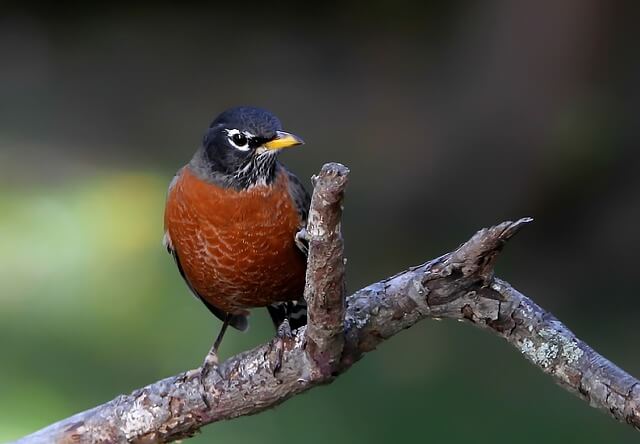
- Length: 7.9-11.0 in (20-28 cm)
- Weight: 2.7-3.0 oz (77-85 g)
- Wingspan: 12.2-15.8 in (31-40 cm)
- Scientific Name: Turdus migratorius
- Frequency of Occurrence: 40.91%
- Maps: Range Map – Sightings Map
- Sounds: Calls and Sounds
The American Robin is a migratory bird that resides in the Northern Hemisphere. The range of this bird includes Alaska, Canada, and the northern United States down to Mexico.
They breed mainly in deciduous or mixed woodlands with dense undergrowth for nesting purposes but can also be found in parks, gardens, and other cultivated areas during migration season (April-September).
For food, it feeds on insects, small animals such as worms and mice, fruits like blackberries and mulberries, grains such as corn or rice kernels. Its migration pattern depends on what season it is in; during winter months, they migrate south to Mexico.
Handpicked Related Post:
- How To Attract Robins To Your Yard – 7 Best Tips!
- 5 Best Bird Feeders For Robins (Tested & Rated For 2022)
- Interesting American Robin Fun Facts (Explained)
Carolina Chickadee
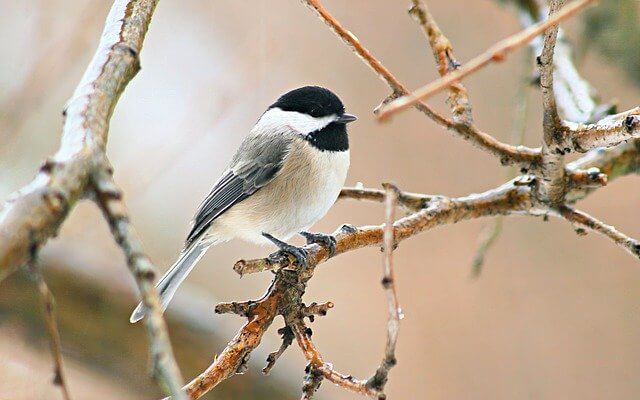
- Length: 4.7-6.0″ in (12.0-15.2 cm)
- Weight: 0.3-0.5 oz (9-14 g)
- Wingspan: 6.3-8.3 in (16-21 cm)
- Scientific Name: Poecile carolinensis
- Frequency of Occurrence: 36.55%
- Maps: Range Map – Sightings Map
- Sounds: Calls and Sounds
The Carolina Chickadee is a small songbird that can be found in eastern North America. They are found in the eastern United States from southern Maine to Florida and west to Nebraska, Missouri, and Louisiana. Their habitat is mostly in deciduous and mixed forests, woodlands, orchards, and residential areas.
These birds are not migratory but they do move around to find food sources and to avoid bad weather conditions such as storms. Their diet consists of insects like caterpillars, ants, wasps, and bees; seeds from fruits like oak acorns and pine cones; nectar from flowers.
Handpicked Related Post:
- Unique Black-capped Chickadee Facts You Need To Know!
- Best Bird Feeder For Chickadees (The Ultimate Guide 2022)
Carolina Wren
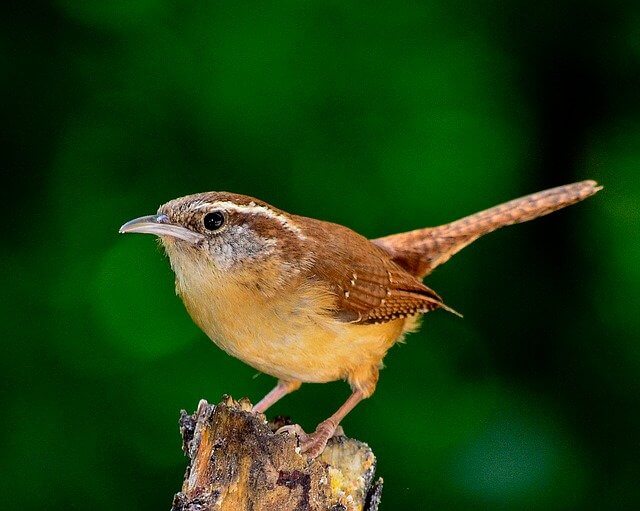
- Length: 4.7-5.5 in (12-14 cm)
- Weight: 0.6-0.8 oz (18-22 g)
- Wingspan: 11.4 in (29 cm)
- Scientific Name: Thryothorus ludovicianus
- Frequency of Occurrence: 40.19%
- Maps: Range Map – Sightings Map
- Sounds: Calls and Sounds
The Carolina Wren is a small, insectivorous songbird found in the eastern United States. The bird’s range extends from Maine to Florida and west to the Mississippi River Valley. It inhabits open country, woodland edges, scrubby fields, thickets, brushy areas, and forest edges, though it can also be found in residential neighborhoods, gardens, parks, and even suburban lawns.
Carolina Wrens feed on insects and spiders as well as seeds and berries from plants such as milkweed, clover, blackberry, and grapes. Carolina Wrens will increase their consumption of fruit during the summer months when insects are less abundant.
Handpicked Related Post: How to Attract Wrens to your Backyard? (Expert’s Guide)
Mourning Dove
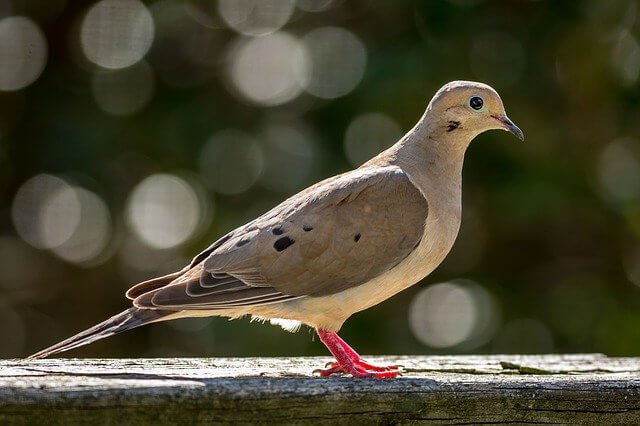
- Length: 9.1-13.4 in (23-34 cm)
- Weight: 3.4-6.0 oz. (96-170 g)
- Wingspan: 17.7 in (45 cm)
- Scientific Name: Zenaida macroura
- Frequency of Occurrence: 42.04%
- Maps: Range Map – Sightings Map
- Sounds: Calls and Sounds
The Mourning Dove is a bird found in North America. The range of the mourning dove includes all of North America, Europe, Asia, and Africa, except for the west coast of Canada. The dove’s habitat ranges from wetland areas to woodlands, but it will only reside in rural settings with scattered trees or groves, with plenty of water to drink from nearby ponds or streams.
They can often be seen nesting on roofs of buildings and other structures. The food these birds eat is mostly grain seeds, berries, weed seeds, and some insects, but also enjoy fresh fruit such as apples, and oranges. The mourning dove is often considered to be a migratory bird, as they fly from north to south during the winter months (October-April) and back again during the summer months (May-September).
Handpicked Related Post: Facts About Mourning Doves – 10 Things You Need To Know!
American Goldfinch
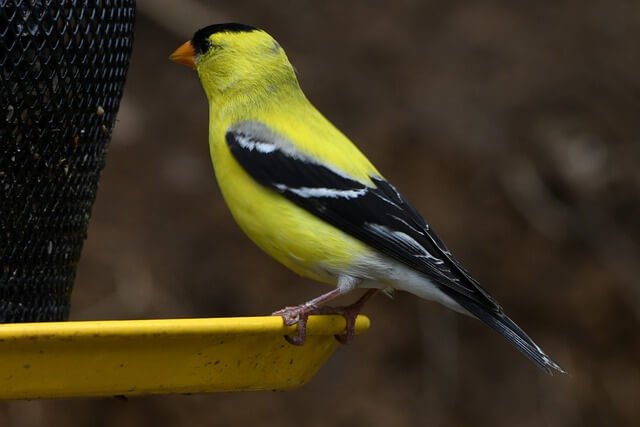
- Length: 4.3-5.1 in (11-13 cm)
- Weight: 0.4-0.7 oz. (11-20 g)
- Wingspan: 7.5-8.7 in (19-22 cm)
- Scientific Name: Spinus tristis
- Frequency of Occurrence: 33.60%
- Maps: Range Map – Sightings Map
- Sounds: Calls and Sounds
The American Goldfinch is a small bird native to North America. It ranges from southern Canada and the United States south through Mexico, Central America, and northern South America. They prefer open habitats such as grasslands, prairies, meadows, pastures, gardens, and parks for breeding grounds.
They eat insects, weed seeds, grains, and berries such as dogwood fruit or juniper berries; they may also eat artificial feeders during winter months when natural food sources are scarce. This species spends the winter months in Central America and northern South America.
Handpicked Related Post: American Goldfinch Interesting Facts
Tufted Titmouse
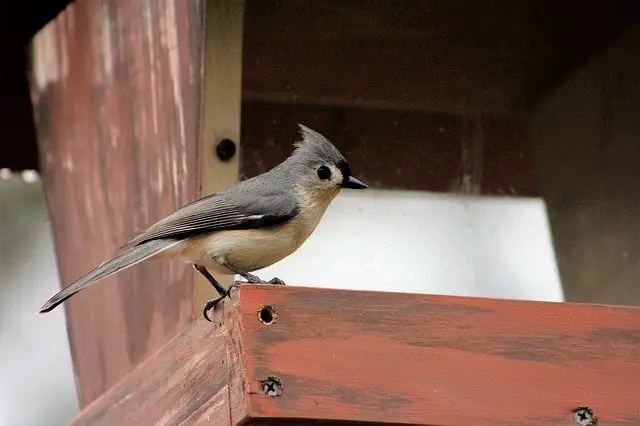
- Length: 5.5-6.3 in (14-16 cm)
- Weight: 0.6-0.9 oz. (18-26 g)
- Wingspan: 7.9-10.2 in (20-26 cm)
- Scientific Name: Baeolophus bicolor
- Frequency of Occurrence: 30.28%
- Maps: Range Map – Sightings Map
- Sounds: Calls and Sounds
Tufted titmice are small woodland birds that live in North America. The tufted titmouse ranges from Eastern Canada to the East Coast of the United States to Western Texas in wintertime. They inhabit coniferous forests and deciduous woodlands. The Tufted Titmouse’s diet consists mainly of insects, fruits, seeds, and berries.
The titmouse’s migration pattern includes movement southward during the winter months of November through March. In the summer, they reside in Central Canada through the Eastern United States. In wintertime, they migrate south to Texas then back north in the spring to nest in Canada again.
Handpicked Related Post: How to Attract Tufted Titmouse to my Yard? (Explained)
Song Sparrow
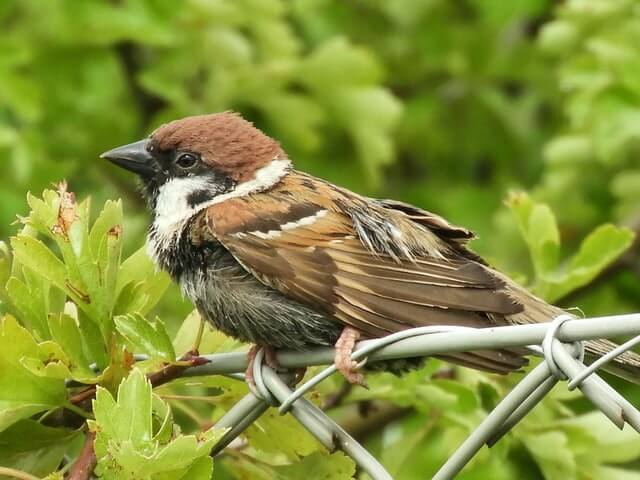
- Length:4.7-6.7 in (12-17 cm)
- Weight: 0.4-1.9 oz. (12-53 g)
- Wingspan: 7.1-9.4 in (18-24 cm)
- Scientific Name: Melospiza melodia
- Frequency of Occurrence: 31.99%
- Maps: Range Map – Sightings Map
- Sounds: Calls and Sounds
The Song Sparrow is a common North American songbird that is usually found in open areas, including parks and fields. They are generally found around cities or other human habitats, marshlands, or wet meadows. The song sparrow is known to have an extensive range throughout North America, from Alaska to Florida, including all states in between.
Their diet consists of insects, spiders, earthworms, and seeds that they can find on the ground. Song sparrows live throughout most of Canada, with some southern populations migrating to warmer climates during winter months.
Handpicked Related Post: How to Attract Sparrows to your Backyard? (Like A Pro)
Northern Cardinal
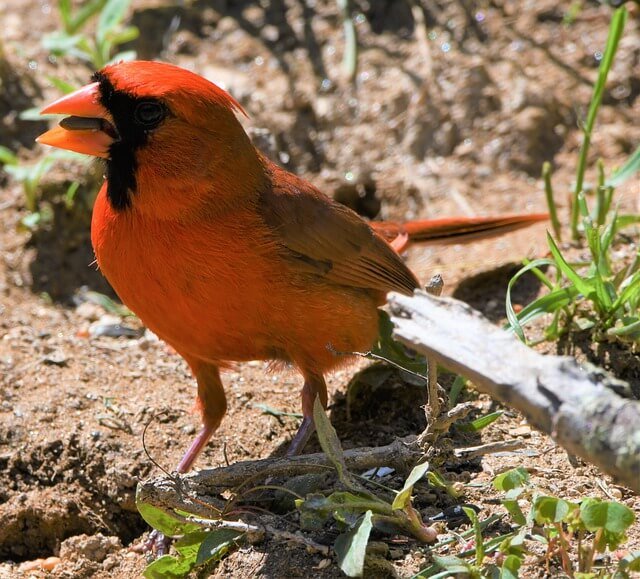
- Length: 8.3-9.1 in (21-23 cm)
- Weight: 1.5-1.7 oz. (42-48 g)
- Wingspan: 9.8-12.2 in (25-31 cm)
- Scientific Name: Cardinalis cardinalis
- Frequency of Occurrence: 50.49%
- Maps: Range Map – Sightings Map
- Sounds: Calls and Sounds
The Northern Cardinal is one of the most common and widespread birds in North America. They are found from Alaska to Florida, west to California, and north to British Columbia. Cardinals can be found year-round in some parts of their range, but migrate seasonally as far south as Mexico or Central America for the winter.
North American cardinals have a wide variety of habitats including forest edges, shrubby areas, woodlands near open fields with scattered trees, and dense evergreen forests. It feeds on seeds, fruits, berries, and insects depending on the season. Cardinals are monogamous for life and may stay together year-round.
Handpicked Related Post:
- 10 Best Bird Feeders for Cardinals (Rated for 2022)
- Best Birdhouse for Cardinals 2022 (Tested And Rated)
- Where are Cardinal Birds Found – Best Places to Look
- Cardinal Bird Facts You Never Knew
European Starling
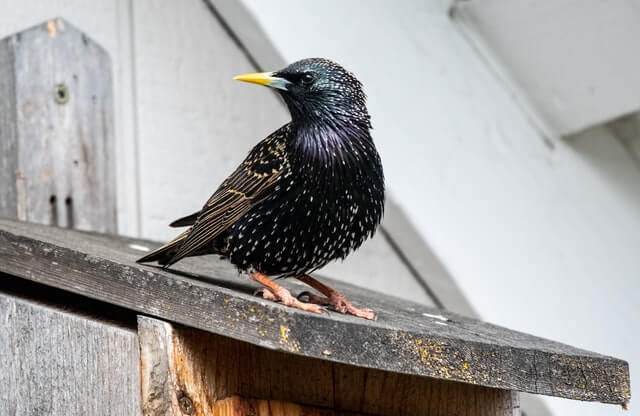
- Length: 7.9-9.1 in (20-23 cm)
- Weight: 2.1-3.4 oz. (60-96 g)
- Wingspan: 12.2-15.8 in (31-40 cm)
- Scientific Name: Sturnus vulgaris
- Frequency of Occurrence: 31.21%
- Maps: Range Map – Sightings Map
- Sounds: Calls and Sounds
The European Starling is a medium-sized bird that is native to Europe and Western Asia. The starling can be found in most parts of the world, as it has been introduced to North America, Australia, New Zealand, and South Africa. The breeding habitat for this species is woodland habitats with thick undergrowth. They prefer old orchards or other neglected gardens.
European Starlings feed on insects, spiders, earthworms, and fruit. They migrate to avoid cold weather during the winter months of November through March by flying southward from the northern United States to Mexico or Central America for the winter before returning north in April or May.
Handpicked Related Post: How To Attract European Starlings To Your Yard Fast?
Blue Jay
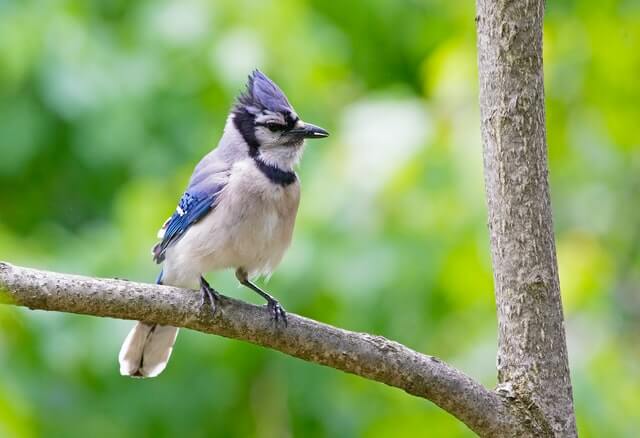
- Length: 9.8-11.8 in (25-30 cm)
- Weight: 2.5-3.5 oz. (70-100 g)
- Wingspan: 13.4-16.9 in (34-43 cm)
- Scientific Name: Cyanocitta cristata
- Frequency of Occurrence: 32.80%
- Maps: Range Map – Sightings Map
- Sounds: Calls and Sounds
The Blue Jay is a bird of the family Corvidae. It’s not only beautiful but also extremely intelligent and can imitate other birds’ calls. The Blue Jay is native to North America, which includes most of Canada and the United States except for parts of New England and Alaska. This bird lives in almost any habitat: deciduous or coniferous forests, swamps, farmlands, towns, parks, and residential areas.
Blue Jays eat insects, nuts, berries, and other fruit from trees as well as some small animals such as mice or frogs. In the winter months, they will migrate south to the tropics of Central America and South America.
Handpicked Related Post:
- How to Attract Blue Jays to your Yard?
- 15 Best Bird Feeders For Blue Jays (Tried & Tested 2022)
- Do Blue Jays Migrate? The Truth
- What do Blue Jay Eat – All The Facts
American Crow

- Length: 15.8-20.9 in (40-53 cm)
- Weight: 11.2-21.9 oz. (316-620 g)
- Wingspan: 33.5-39.4 in (85-100 cm)
- Scientific Name: Corvus brachyrhynchos
- Frequency of Occurrence: 28.72%
- Maps: Range Map – Sightings Map
- Sounds: Calls and Sounds
The American Crow is a type of bird that lives in North America. They are found on the East Coast, from Canada to Virginia, and then westward to Kansas. They have been observed migrating as far south as Argentina and as far north as Alaska. The crow’s habitat ranges from woodland areas near water sources like lakes or rivers to more open habitats such as fields with few trees or large cities.
Crows are omnivores, meaning they eat both plants and meats. Their diet includes earthworms, insects, berries, eggs from other birds’ nests, and small animals such as mice or frogs. A crow’s eating habits vary depending on its location.
Handpicked Related Post: How To Attract Crows To Your Backyard: Expert Tips!
Gray Catbird
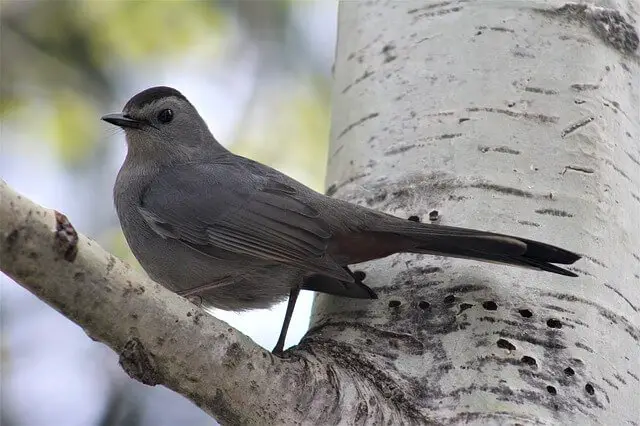
- Length: 8.3-9.4 in (21-24 cm)
- Weight: 0.8-2.0 oz (23.2-56.5 g)
- Wingspan: 8.7-11.8 in (22-30 cm)
- Scientific Name: Dumetella carolinensis
- Frequency of Occurrence: 22.81%
- Maps: Range Map – Sightings Map
- Sounds: Calls and Sounds
The Gray Catbird is a bird of the family Mimidae. The Gray Catbird is a type of bird that has a range across the eastern half of North America. Its habitat is typically found in forests, and its food source is mostly insects. They migrate during late summer to spend the winter months in Central America.
The Gray Catbird can be found throughout most of Eastern North America, excluding Canada and extreme northern New England, as well as Cuba and Jamaica. The species lives mainly in deciduous or mixed forest areas with dense undergrowth such as scrub or briar patches.
White-throated Sparrow

- Length: 6.3-7.1 in (16-18 cm)
- Weight: 0.8-1.1 oz. (22-32 g)
- Wingspan: 7.9-9.1 in (20-23 cm)
- Scientific Name: Zonotrichia albicollis
- Frequency of Occurrence: 25.30%
- Maps: Range Map – Sightings Map
- Sounds: Calls and Sounds
The White-throated Sparrow is a small bird that can be found throughout North America. They inhabit a variety of habitats, but prefer woodlands with brushy areas and open fields. They are often seen in residential yards, where they will eat the seeds from the feeders or take food from birdbaths.
They live in scrubby vegetation on hillsides and mountainsides. The majority of their diet consists of insects, spiders, worms, and seeds. These birds have been seen to migrate from their summer range of southern Canada and the northeastern United States to winter ranges farther south in the eastern United States or Mexico, Central America, or South America.
Red-bellied Woodpecker
- Length: 9.4 in (24 cm)
- Weight: 2.0-3.2 oz. (56-91 g)
- Wingspan: 13.0-16.5 in (33-42 cm)
- Scientific Name: Melanerpes carolinus
- Frequency of Occurrence: 29.60%
- Maps: Range Map – Sightings Map
- Sounds: Calls and Sounds
The Red-bellied Woodpecker is a North American woodpecker. They are often found in the Eastern United States and parts of Canada. The range of this bird includes parts of Maine, New York, Michigan, Minnesota, Oklahoma, and Texas. This bird’s habitat includes deciduous forests with trees such as oak, hickory, and beech trees; it also resides in the mixed pine-oak forests where there are plenty of dead snags for nesting cavities.
The red-bellied woodpecker’s diet consists of nuts, seeds, berries, insects like beetles and ants, and other small invertebrates. The woodpecker migrates south for the winter to warmer climates, such as Mexico or Guatemala.
Handpicked Related Post: How to Attract Red-bellied Woodpeckers to your Yard?
Common Grackle
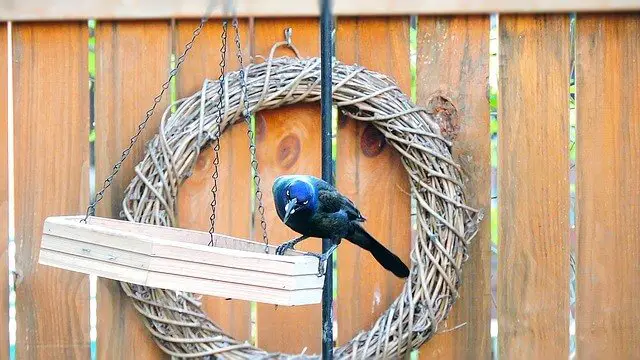
- Length: 11.0-13.4 in (28-34 cm)
- Weight: 2.6-5.0 oz (74-142 g)
- Wingspan: 14.2-18.1 in (36-46 cm)
- Scientific Name: Quiscalus quiscula
- Frequency of Occurrence: 24.96%
- Maps: Range Map – Sightings Map
- Sounds: Calls and Sounds
The Common Grackle is a small, black bird that can be found throughout North America. Its range stretches from Alaska to the southernmost part of South America, and its habitat varies depending on location. They have adapted to live in almost every habitat from coastlines to high mountains, but are most commonly found near open water and wetlands.
Common Grackles feed primarily on insects and grains, but will also eat seeds and berries when necessary. Their migration pattern is similar to other migratory birds as they head south for the winter months and north for the summer months, with some exceptions due to their proximity to the equator.
Northern Mockingbird

- Length:8.3-10.2 in (21-26 cm)
- Weight: 1.6-2.0 oz (45-58 g)
- Wingspan: 12.2-13.8 in (31-35 cm)
- Scientific Name: Mimus polyglottos
- Frequency of Occurrence: 25.59%
- Maps: Range Map – Sightings Map
- Sounds: Calls and Sounds
The Northern Mockingbird is a migratory bird that ranges from southern Canada to the northern parts of South America. They are also common in parts of Missouri, Kansas, and Nebraska but their range extends to all states east of the Rocky Mountains as well as some western states such as Nevada and California. Northern mockingbirds are found in most habitats, including open country, woodland edges, and forest clearings.
The Northern Mockingbird’s diet consists mainly of insects and fruits with some spiders or small vertebrates such as lizards and mice. The Northern Mockingbird is a migratory bird that ranges from southern Canada to the northern parts of South America.
Handpicked Related Post: How to Attract Mockingbirds to your Yard? (Expert Tips)
Downy Woodpecker
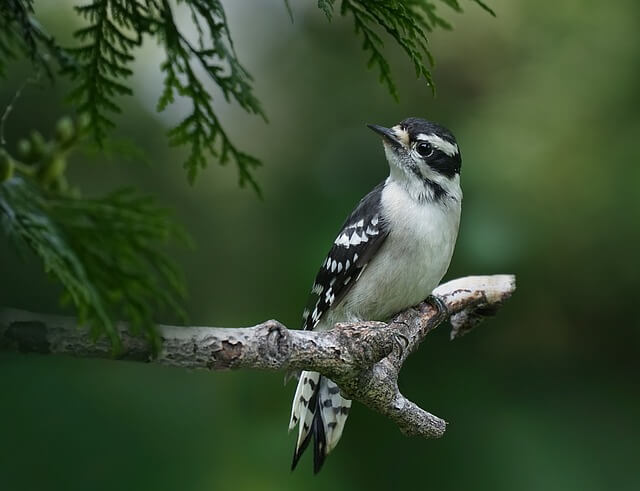
- Length: 5.5-6.7 in (14-17 cm)
- Weight: 0.7-1.0 oz. (21-28 g)
- Wingspan: 9.8-11.8 in (25-30 cm)
- Scientific Name: Picoides pubescens
- Frequency of Occurrence: 27.14%
- Maps: Range Map – Sightings Map
- Sounds: Calls and Sounds
The Downy Woodpecker is a common species of woodpecker in North America. They are most often found living in deciduous forests and mixed hardwood-coniferous forests, though they will occasionally venture into old orchards, residential areas, parks, and other suburban habitats. They prefer to live in lowland coniferous forests because it gives them the best opportunity for nest sites (which are usually holes drilled into trees).
Downy Woodpeckers live year-round in areas with warmer climates like Florida or California, but migrate to colder regions for winter months, such as Texas or New York. Downy Woodpeckers primarily eat insects such ants, beetles, bees, and wasps that they find on trees by looking up into tree bark crevices.
Handpicked Related Post: How to Attract Downy Woodpeckers to Your Yard? (Easy!)
House Finch

- Length: 5.1-5.5 in (13-14 cm)
- Weight: 0.6-0.9 oz. (16-27 g)
- Wingspan: 7.9-9.8 in (20-25 cm)
- Scientific Name: Haemorhous mexicanus
- Frequency of Occurrence: 26.40%
- Maps: Range Map – Sightings Map
- Sounds: Calls and Sounds
The House Finch is a species of finch that can be found in North America. They live in the Western and Eastern parts of Canada, and range all the way to Alaska. House Finches live in many habitats including meadows, grasslands, marshes, and forests.
Some migrate north during winter while others stay year-round south of their range where they are found. The diet consists mainly of grains, weed seeds, ragweed, amaranth, wheatgrass, and fruits that can be eaten off the tree or picked from the ground when foraging.
Handpicked Related Post: How to Attract House Finch to your Yard? (Easy & Fast)
Dark-eyed Junco

- Length: 5.5-6.3 in (14-16 cm)
- Weight: 0.6-1.1 oz. (18-30 g)
- Wingspan: 7.1-9.8 in (18-25 cm)
- Scientific Name: Junco hyemalis
- Frequency of Occurrence: 16.17%
- Maps: Range Map – Sightings Map
- Sounds: Calls and Sounds
They are found throughout North America, Central America, and northern South America. The Dark-eyed Junco’s habitat includes fields, meadows, woods edges, and scrublands. These birds feed on seeds in the wintertime, while during the summer they eat insects. The diet of this junco includes seeds, berries, fruit, and invertebrates which it usually finds on or near the ground where it feeds during both day and night hours.
They are migratory birds that migrate to a wintering ground during the colder months of November through March. They return north for nesting season from April to July, traveling at night while avoiding predation by owls and hawks.
Handpicked Related Post: Fun Facts About Dark-eyed Juncos
Baltimore Oriole
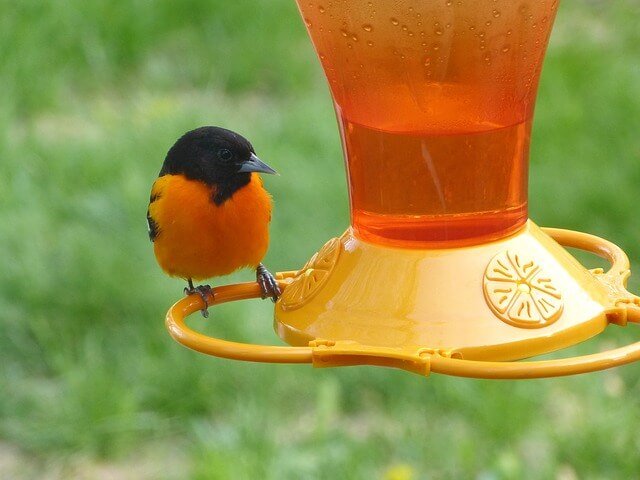
- Length: 6.7-7.5 in (17-19 cm)
- Weight: 1.1-1.4 oz (30-40 g)
- Wingspan: 9.1-11.8 in (23-30 cm)
- Scientific Name: Icterus galbula
- Frequency of Occurrence: 3.49%
- Maps: Range Map – Sightings Map
- Sounds: Calls and Sounds
The Baltimore Orioles are migratory birds that travel the eastern United States, ranging from as far north as Canada to the southern tip of Florida. They can be found in a variety of habitats, including fields and pastures, open countrysides, and parks.
Their diet includes small invertebrates such as grasshoppers, beetles, and caterpillars which they find on the ground or in low vegetation. The Baltimore Oriole can be found during their breeding season from April to July and October to November, when they migrate south for the winter months.
Handpicked Related Post:
Indigo Bunting

- Length: 4.7-5.1 in (12-13 cm)
- Weight: 0.4-0.6 oz (12-18 g)
- Wingspan: 7.5-8.7 in (19-22 cm)
- Scientific Name: Passerina cyanea
- Frequency of Occurrence: 9.89%
- Maps: Range Map – Sightings Map
- Sounds: Calls and Sounds
The Indigo Bunting is a small songbird that breeds across North America, Central America, and northern South America. It has the widest distribution of any bird in North America. The most common habitat for this bird is woodland edges and scrubland of the eastern coastal plain.
They feed on insects that they find on leaves or tree bark, also berries such as elderberries, juniper berries, and poison ivy berries; sometimes seeds too. The Indigo Bunting has an interesting migration pattern which usually starts in March and ends by the end of September.
Handpicked Related Post: How to Attract Indigo Bunting to your Yard? Expert Tips!
Newly Added Common Backyard Birds (Updated):
- Red-winged Blackbird (41.11% Frequency of Occurrence)
- Tree Swallow – 21.61%
- Northern Flicker – 19.72%
- House Sparrow – 18.55%
- Common Yellowthroat – 16.53%
- Barn Swallow – 16.29%
- Eastern Towhee – 16.05%
- Eastern Bluebird – 15.20%
- White-breasted Nuthatch – 15.11%
- Brown-headed Cowbird – 14.92%
- Chipping Sparrow – 14.85%
- Yellow-rumped Warbler – 11.90%
- House Wren – 11.58%
- Purple Martin – 10.63%
Frequently Asked Questions
Are there magpies in Delaware?
There are no Magpies in Delaware, and it is highly unlikely that they exist in the state. The nearest population of magpies to Delaware is in southern Pennsylvania and eastern Ohio.
Are there roadrunners in Delaware?
The answer is yes. They are not common, but they do exist in Delaware. Roadrunners are birds of the cuckoo family and live in the deserts of Arizona, New Mexico, Texas and northern Mexico.
Are Carolina wrens in Delaware?
Carolina Wrens are found in Delaware, with a 38% frequency of occurrence. They can be seen from April to October and most often during the summer months.
Do bluebirds live in Delaware?
Eastern bluebirds live in Delaware during the spring and summer, with a 15.2% frequency of occurrence in 2022. They make an appearance in Delaware every year for a few months from April through July, before they head south again for the winter.
How many species of birds are there in Delaware?
There are currently 440 species of birds that have been documented in Delaware in 2022. This number is steadily increasing as more and more bird enthusiasts get involved in documenting the birds that live here.
Is it OK to feed birds in Delaware?
Birds are often seen as pests that need to be removed from an area, but in Delaware, it is perfectly legal to feed birds. Birds can provide important ecological services by keeping ecosystems healthy and cleaning up pollution. There are many benefits of feeding birds, and it is a good way to show your appreciation for their presence.




